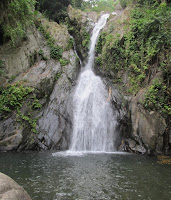Tourist Attractions
 |
| Mt. Guiting-Guiting |
Mt. Guiting-Guiting,
Sibuyan Island, Romblon
Romblon's
highest peak. It is an attraction to mountaineers and is the province's major
source of timber and metallic products. It is also abundant with wildlife,
plant species, and waterfalls.
Cantingas River, Taclobo, San Fernando, Romblon
Cantingas River, Taclobo, San Fernando, Romblon
 |
| Cantingas River |
Known
for its enchanting vistas. In its mountain are found the world's smallest bat,
the endangered wild cat or the singalong, and the hardest wood, the mancogo or
iron wood. Cantingas River Valley is known to have the second cleanest inland
water in the region.
 |
| Busay Falls |
Busay Falls, Panangcalan, San Fernando, Romblon
 |
| Isla de Gallo |
Desciption:
One of the last remaining untouched falls in the Philippines.
Isla de Gallo, Azagra, San Fernando, Romblon
The
coral reefs around the island, with its white sands, are well known for good
diving.
 |
| Lagting Falls |
Lagting Falls River,
Taclobo, San Fernando, Romblon
 |
| Lambingan Falls |
Lambingan Falls, Magdiwang, Romblon
The
natural crystal-clear pool is ideal for a dip. A favorite dating place among
lovers.
Guyangan Caves, Banton, Romblon
 |
| Guyangan Cave |
Centuries-old
coffins made of hollowed logs were discovered in the caves. Guyangan caves was
discovered in 1936 and not after the war.
Lis-Ong Cave, Colong-colong, Corcuera, Romblon
Cotta Tower, Pob. Corcuera, Romblon
The
remains of a Spanish Fort constructed between 1860-1865 by San Agustin de Pedro
to ward off Muslim pirates. It is situated on hill overlooking the town.
 |
| Cotta Tower |
Romblon is an island province of the Philippines located in the MIMAROPA region in Luzon. The province consists of numerous islands sitting in the Sibuyan Sea. The three major islands are Romblon Island, Tablas Island and Sibuyan Island. Romblon is subdivided into 17 municipalities. Its capital is the municipality also named Romblon located in Romblon Island. The province lies south of Marinduque and Quezon, east of Mindoro, north of Aklan and Capiz, and west of Masbate.
The province of Romblon was
formerly called Lomlom,which refers to an act of a hen nesting to warm her
eggs. This is based on the fact that when a Spanish soldier was ordered to ask
the natives the name of the island; he accidentally pointed to a place where a
hen is nesting and the native answered lomlom, hence a misinterpretation. The
name was later corrupted to the word Domblon.

The majority of the inhabitants of Romblon are Visayan; some Negritos are found
in the interior of the province. There are three distinct languages spoken as a
native language by Romblon’s inhabitants; they are Romblomanon or Tiyad Ini
including many variants of Sibuyanon dialects; Bantoanon or Asi; and Inunhan or
Onhan. Hiligaynon, Tagalong and English are also used in the province. The
people of the province are mostly Christians; about 75% belongs to Roman
Catholic and 25% to other Christian denominations.
Romblon is endowed with lush vegetation and mineral
resources. It is the country’s leading producer of high-quality marble,
comparable to that of Italy. Aside from marble, the province is also rich in
granite, nickel, silica, mercury, zinc, copper, silver, limestone, sulfide,
ores, kaolin, clay, magnesium and quartz. Gold panning sites have sprouted in
some of the mountain stream areas in Magdiwang, Sibuyan Island.
The fertile soil nurtures varied agricultural crops like
coconut, rice, corn, bananas, rootcrops, fruit trees, vines and many others.
Offshore, Romblon is a rich fishing ground. The islands lie in the migratory path
of fishes from the Sulu and Visayan Sea, passing the Tablas Strait, Sibuyan Sea
and Romblon Pass.
The province of Romblon is classified as a third class
province. Since it is situated at the center of the archipelago, Romblon links
the supply areas of Luzon, Visayas and Mindanao. The province is also an ideal
location for supply distribution and light manufacturing ventures. The capital
town of Romblon and the port town of Odiongan are the province’s trade and
commercial centers.
Romblon is the
country's leading producer of high-quality marble, comparable to that of Italy.

No comments:
Post a Comment
What is in your mind?